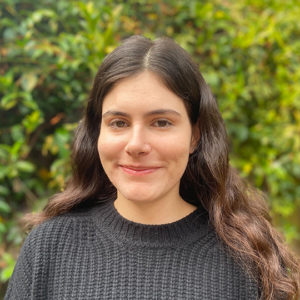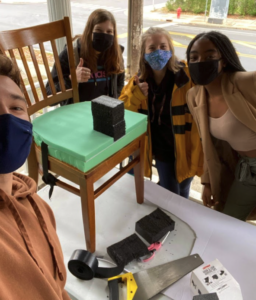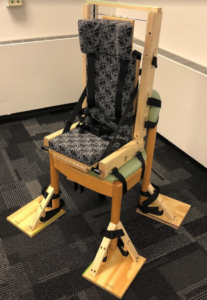BlueLab EASE: Socially Engaged Design in Practice
Sara Groenke, C-SED’s Program Assistant, also serves as the design lead for BlueLab EASE – a student project team that aims to create more supportive, adaptable, and accessible seating solutions for children with cerebral palsy in León, Nicaragua.
Story by Lawryn Fraley

Sara Groenke ’22, Stamps School of Art & Design and College of Engineering Student
Sara was introduced to BlueLab EASE during her fourth year at Michigan when on the hunt for a student project that had a social impact component in addition to the opportunity to learn hands-on, engineering skills. She was immediately drawn to the project’s real-life applications, we have real stakeholders and we’re partners with a real community. That made all the learning from the classroom feel like it was useful.”
Sara’s experience designing a tool for better wheelchair seating for children with cerebral palsy in Nicaragua melded her classroom experiences from both the Stamps School of Art & Design and the Department of Mechanical Engineering. Sara and her team relied on their engineering backgrounds to plan ahead for interviewing stakeholders, purchasing materials, and building prototypes, while utilizing art and design inspired imagination and spontaneity when things didn’t quite go as planned. She learned to appreciate the nuances of designing from both an art and an engineering perspective: “sometimes it’s nice to have a plan, but sometimes it’s also nice to just try and figure things out in the moment.” To Sara, BlueLab EASE benefitted from both design perspectives and they equally contributed to the direction of the project from the very beginning.

BlueLab EASE team members with one of their first prototypes.
Given that the stakeholders for BlueLab EASE are in another country, Sara’s team relied heavily on the Socially Engaged Design Process Model to keep themselves hyper aware of any assumptions they might be making throughout the design process. For example, the student team couldn’t assume their product users spoke English, or could read, so they incorporated color-coding into the assembly process and more images into the user manual. The students on the project team are constantly evaluating their social identities as designers and the impact those identities have on the product. This self-awareness is core to the Socially Engaged Design Process Model.

BlueLab EASE’s foot support technology developed for children with cerebral palsy.
In addition to self-awareness, the BlueLab EASE team is also dedicated to sustainable design. In fact, EASE stands for Enabling Accessibility through Sustainable Engineering. Their mission is to create a solution without creating a dependency: “they will have all the information. They can source all the materials locally and, using their own skills and their own people, can take this idea and move forward even more with it”. Sara hopes that if this project helps people in one community, that one day it can be shared widely to assist people from all communities with similar needs.
With the first prototypes recently delivered to stakeholders, BlueLab EASE is that much closer to fulfilling their mission. Without training and access to the C-SED Lab space or Shanna Daly’s Front-End Design course, Sara and her team might not have been as successful as they are today. With her role as project lead coming to a close, Sara reflected on her experience with C-SED and hopes more student designers take advantage of the community and resources, “there’s lots of really bright people at C-SED who are always happy to talk about anything related to your design process and would love to meet with you.”

BlueLab EASE’s chair insert technology developed for children with cerebral palsy.
Sara will wrap up her final semester at the University of Michigan with degrees from both the College of Engineering and Stamps School of Art & Design. She hopes that BlueLab EASE will be inspired by the implementation of this first round of prototypes to their end-users in Nicaragua, and that they will continue to realize new prototypes that learn from these ones. “This is really just the beginning. There’s so much more we can still do.”
Continue to follow along with BlueLab EASE on Facebook and Instagram.
.



